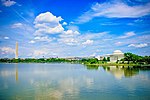National Cherry Blossom Festival
Annual events in Washington, D.C.Cherry blossom festivalsFestivals in Washington, D.C.Flower festivals in the United StatesJapanese-American culture in Washington, D.C. ... and 4 more
Japan–United States relationsLandmarks in Washington, D.C.March 2020 events in the United StatesSpring festivals in the United States

The National Cherry Blossom Festival is a spring celebration in Washington, D.C., commemorating the March 27, 1912, gift of Japanese cherry trees from Mayor Yukio Ozaki of Tokyo City to the city of Washington, D.C. Mayor Ozaki gave the trees to enhance the growing friendship between the United States and Japan and also celebrate the continued close relationship between the two nations. Large and colorful helium balloons, floats, marching bands from across the country, music and showmanship are parts of the Festival's parade and other events.
Excerpt from the Wikipedia article National Cherry Blossom Festival (License: CC BY-SA 3.0, Authors, Images).National Cherry Blossom Festival
Ohio Drive Southwest, Washington
Geographical coordinates (GPS) Address Nearby Places Show on map
Geographical coordinates (GPS)
| Latitude | Longitude |
|---|---|
| N 38.881666666667 ° | E -77.035 ° |
Address
Ohio Drive Southwest
Ohio Drive Southwest
20228 Washington
District of Columbia, United States
Open on Google Maps










